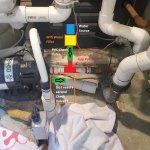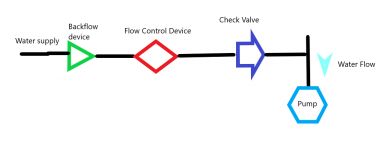OK... here are some ideas for you.
1.
Pentair makes a product that provides auto-leveling at the pad. Minimal plumbing, and all the remote goodness you might crave. This is an auto-filling solution, so once you get it working, you don't have to monitor how low the pool is, or try to guess what the correct amount of "on time"would be for each day (which is going to change throughout the season). This product takes care of everything for you. I don't have any direct experience with that product, or how well it works, but maybe you want to take a look.
The best water level for new construction with pool automation. With the IntelliLevel Water Leveling Monitor’s multi-sensing technology, your pool’s water level stays at just right amount, no more overflowing or wasting water.

www.pentair.com
2.
Pressure-side cleaning systems are a product of the past, and are the least energy-efficient way to clean your pool, because you need to run two pumps to get them to go. Consider replacing your tired cleaner with a modern robot. Again, I've never owned one, but many here swear by them. They do seem to be the most energy-efficient way to clean a pool, plus they actually brush the finish for you (something other cleaners don't really do), even up on the water-line tile. The reason I suggest that is it would then free up that pressure line. With that, you could install a true auto-leveling system, that both auto-fills
and auto-drains, both to whatever level you set (fully adjustable). So you'd never have to think about your water level again, no matter how hot it gets, or how much it rains. This one I actually
do have experience with. Below is a link to the unit I have. Mine is next to my skimmer, but these can be installed away from your pool. Up to 30' away, I think. Which means it could be right by your pad if that's not too far away. You'd connect it to the existing pressure line, and a water supply. If you want auto-draining, too, then you'd also connect it to a line that can carry water away (down a hill or off to the street, depending on local ordinances regarding draining pool water). I believe there are several brands of these, this is the one I have and it works great:

poolmiser.com
@Newdude is building a pool in NY and is passing on an auto-leveling system, which I still don't quite understand, because I wouldn't want a pool without one. But maybe he can give you some thoughts on the subject.
3.
There might be some way to use an automated 3-way valve to plumb both a PoolMiser auto-leveler
and still keep your pressure-side cleaner going, if you're interested in both. I'd have to think about the right way to do that.
4.
You could run a manual fill pipe to your pool, connected to some sort of wifi-timer-valve, as per your original idea. Instead of drilling out the side of the pool, you just cut a groove in your deck, just wide and deep enough to contain a 1/2" PVC pipe, which would be connected to a timed water supply. You then cover the pipe and fill the groove with expansion sealant, and before it dries you sprinkle on some sand. It'll look like a grout line. If you don't want to cut through your coping, you could lead this pipe to your skimmer, and just angle it down a bit into the skimmer well. Your fill water would enter the pool through the skimmer, which should be fine. I've done something similar to my deck. I just happened to have a contraction groove that led right to my skimmer, so I used that.
5.
If you go with your original idea, you want the fill water to enter
after the booster pump, because you probably shouldn't send unfiltered water through the pump. It might not be so bad where you live, but where I live the supply water is full of minerals and calcium that would eventually mess with the pump. You do need a pressure backflow preventer (BFP) any time you have a valve, any sort of valve, downstream of it. That's because the downstream valve maintains constant, full pressure on the BFP, and that BFP valve needs to be rated for that. Hose bibb and sprinkler valve anti-siphon BFP devices are not rated to be under constant pressure and will eventually fail because of it.
The BFP I recommended above might be able to serve as one of your check valves, I'll have to check with my BFP guru about that if you're going to stick with your original idea. Referring to the drawings above, that check valve is in the wrong place. You don't need one there, as the wifi-valve is doing that job (and the BFP is the backup to that). You need one on the other line (where you were asking about),
before the tee, to keep fill water from back-flowing through the booster pump and then on to your filter and filter pump. You probably don't need to protect the booster, but you definitely don't want to send water the wrong way through your filter.





